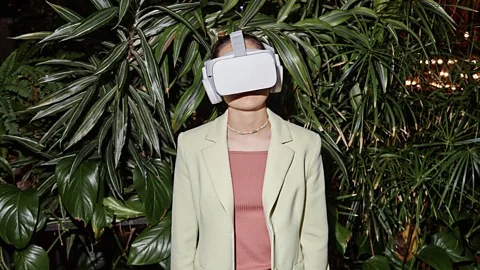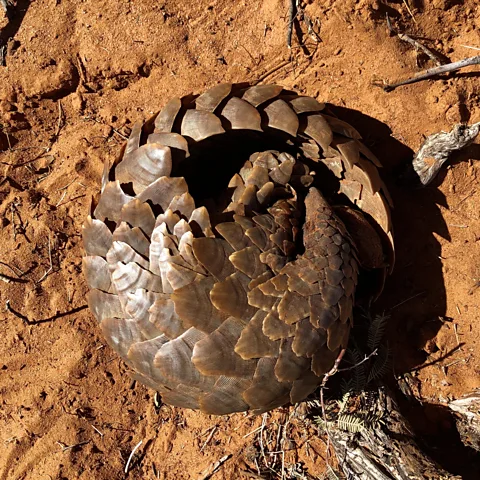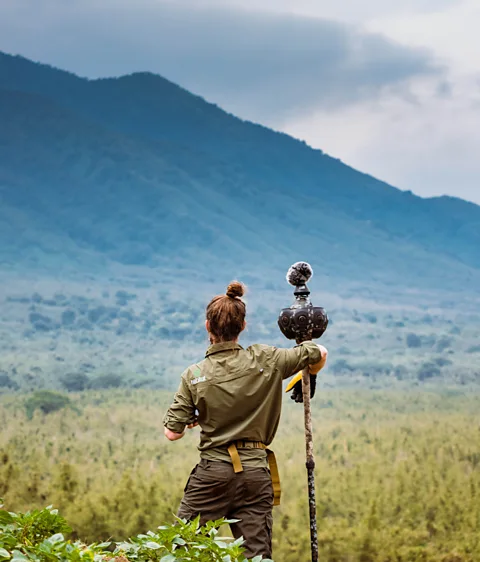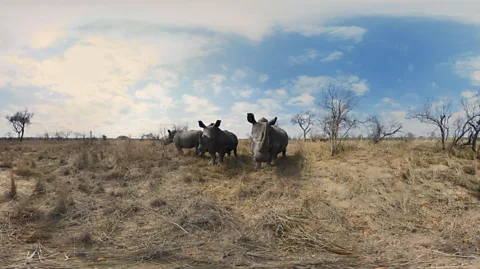 Getty Images
Getty ImagesFor many people, the constant bad news overcomes our reaction to climate disaster. But research suggests that a new type of comprehensive story about the nature shown through virtual reality (VR) can build empathy and inspire us to act.
I’m crying in a VR headset. I have just seen a VR experience telling the story of a new pangoline called chestnut, while it struggles to survive the desert of Kalahari. A wide, dusty landscape lies around me in all directions, and her armored body looks vulnerable while she’s curly, only, to sleep. Her story is based on the life of a real pangoline that was traced by scientists.
Chestnut has not found enough for ants to eat, as insect numbers have been reduced due to climate change. Her sunny voice remains optimistic even when exhaustion takes over. In the last scenes, it dies, and I need to lift the headphones to lift my eyes.
VR experiences can be much more than just moving or having fun, the research suggests. Scientists are discovering that the experiences of nature presented through VR can affect our attitudes and behaviors – and that these arresting descriptions of nature can make us better care of our environment.
My powerful VR experience with chestnut history was made by Habitatxr, a Johannesburg -based production studio. Founder Ulrico Grech-Cumbo launched the company in 2016, following many trips to African bush during which he captured her green, dusty landscapes and wild iconic camera life. He had experience to work in VR, and realized that he could translate his images into something more diving.
“I thought it would be a hell of a lot of dog entertainment within a natural history documentary,” he says.
 Habitatxr
HabitatxrHabitatxr is just one of the companies that experiment with VR technology to create nature experiences. DivingLocated in Paris, they receive their submersible films of underwater worlds and snowscapes in scientific centers and aquariums. And the collective of artists in the UK Marshmallow laser holiday They have created comprehensive experiences showing the forest through the eyes of a dragon, and get the “inside” the tree.
Nature experiences developed by Habitatxr are located in a virtual version of African savannah. In one, I find myself in a foggy landscape painted with flat, flat tip. Suddenly a rhinoceros appears, near dangerous, its large horn that crashes the air as it walks towards me and lowers its head.
Despite the pixeled graphics, I instinctively look where my knee should be – where Rhino’s horn should have grazed. The beast allows for a snoring of breathing and, with mercy, withdraws.
I’m starting to see how emotionally this kind of storytelling can be. And I’m not just-when an environmental NGO got one of the VR Habitatxr experiences in a funding gala, Grech-Cumbo saw the powerful effect it had on those who viewed it. “High value individuals were strolling with expensive hours and glasses of champagne,” he says. “We will lower them in a dark room and put a randy rape on them, and five minutes later, they will cry. That’s not something I have ever seen a movie [to] 50 people at a time. “
 Habitatxr
HabitatxrGrech-Cumbo observation is reflected in scientific research, which reveals that VR tends to cause stronger emotions than other media. Engaging in a VR experience in relation to a Syrian refugee bring more intense emotions than to read an article that shows the same images and information, for example.
There may be special benefits for VR content that deals with nature. An experience of nature describing a forest of magnificent trees, for example, made people more likely to take action To protect the environment, such as signing a petition on lowering plastic or receiving leaflets to spread the word with respect to the petition. Another, of a journey through the Amazon rain forest, found that the participants who experienced the forest through the VR reported that they felt more related to nature and express more Commitment to the environment than participants who viewed the same visual rain forests on a standard computer screen.
 Habitatxr
HabitatxrAlice Chirico, a psychologist at the Catholic University of the Holy Heart in Milan, Italy, has studied VR’s ability to make us feel scared, and how it can affect people’s relationships with the natural world. She has discovered that the experiences of nature VR make us feel scared when they cause a sense of infinity – like large mountains and tall trees. In another study, she found that these kinds of frightened virtual experiences of nature made people more prone take Social actions directed toward protectionsnapper the environment.
“AWE is able to support positive attitudes to the environment and also a sense of environmental connection – a kind of natural connection, the feeling of involvement within something that is much greater than us,” Chirico says.
VR can do this in ways that other media formats cannot, she says, because it can take us away in a story and create the illusion that we are part of it. Vra “manipulates the feeling of presence,” Chirico says, creating “the illusion of being there really in that specific place at that specific moment, as if it were reality itself.”
The comprehensive VR advantage may have against other media such as articles or videos may have real -world influences. Researchers have discovered that people are most prone to saving home energy When learning about the need for pro-environmental behavior through VR, rather than from an article or video. They suggest that the difference is because of what they call “mechanism of presence” – the feeling of being really in the world.
These experiences usually bring the viewer close to their subject – face to face with a gorilla, or inside a wild migratory herd. However, feelings of immersion in such scenes can be limited by current technology. For me, Rhino swinging with horns was surprising, though it was not visually reliable. Researchers suggest that High -resolution -rich images It is important for immersing viewer in experience. VR Tech is likely to improve in the coming years, as accessories increase the realism of virtual worlds. There is a Gloves able to persuade her clothing That a spider is crawling throughout their hand, for example.
Despite decades of excitement over VR, technology has fought to explode in the main flow. Even today, relatively few people have access to VR headphones, with only around 10m of equipment sold across the globe every year. Reports suggest that Apple’s long-awaited Vision Pro headphones, for example, which costs $ 3,499 in the US and £ 3,499 in the UK-has reached a portion of its expected sales.
 Habitatxr
Habitatxr“Although I’ve worked in this world for 10 years, there is probably a nine of 10 chances that if you put a person’s headset, it’s their first time wearing a VR headphone,” says Grech-Cumbo.
Even if technology were more accessible, can virtual experiences blind our appreciation for the local, everyday nature? Important, admits Grec-Cumbo, that the experiences of the attractive VR nature do not distract us from the real forests, parks and go to the mountains near where we live.
“This is about understanding our relationship with nature, wherever we are,” he says.
Given this, Habitatxr is now working on a project that will bring virtual nature to the cities, starting with Johannesburg. Their plans for a “Zoo of the Future” will include an online life experience, in which people will be able to practically receive individual species – flowers, herbs, animals – from an ecosystem map, and see their ecological links with other species.
“[We want to] Put an emphasis on the fact that we are all connected-whether we believe it or not, whether we like it or not, ”says Grech-Cumbo.
Chirico points out that the purpose of VR should not be to replace reality and nature. There are many things that virtual nature cannot do. Studies suggest that Could not increase our mood In the same way, true nature can, for example. However, it can be a democratization. “People don’t [always] Have full or easy access to nature, so the goal is to provide it in a cheaper way, ”Chirico says.
In the SH.BA, for example, 100 million peopleIncluding 28 million children, they are reported to have no access to parks near their homes. The experiences of nature VR, in such cases, can allow people to interact with an unrealistic but informative and inspiring version of nature. Plus, adds Chirico, “there is a fact that you do not need to move out of your home, so emissions are reduced – you can explore amazing panorama that would otherwise require hours and hours of travel or car.”
While striking through tears towards the end of Habitatxr’s history of Chestnut Pangoli, some white text sailed before me before rolling out the loans: “This is not a story about the pangolins. Or ants. Or even climate change. This is a story for us,” reads – a reminder that people are part of the same ecosystem.
“Comprehensive message,” says Grech-Cumbo, “is that we are a part of nature, not the opposite of nature.”
For a long time, news of technology trusted by global correspondents in your box, sign up at Deciphering technology bulletinWHEREAS Essential list Provides a hand selection of features and penetration twice a week.
For more science, technology, environment and health stories from the BBC, follow us Facebook, XAND Instagram.
